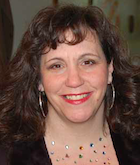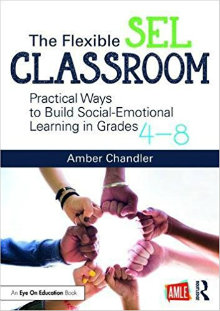Practical Ways to Build SEL in Grades 4-8
The Flexible SEL Classroom: Practical Ways to Build Social Emotional Learning in Grades 4-8
By Amber Chandler
(Routledge/AMLE, 2018 – Learn more)

You know those great talks teachers sometimes have after they attend a wonderful conference session or read an interesting blog?
Or those after school informal problem-solving, idea-making, curriculum-writing sessions that happen when two or more teachers sit on student desks recapping the day?
That kind of organic, home-grown, professional development that leaves you charged and ready to do great things? They’re terrific, right? Well, that’s what Amber Chandler’s new book feels like.

This is not your touchy-feely SEL book
Okay, praise aside, I have to confess that even though I often write about issues that fall under the umbrella of social and emotional learning, I have, over the years, developed an aversion to the SEL label. As a practical teacher who is keenly focused on academic achievement and core curricula, I often find SEL materials to be too “touchy feely” for me.
Chandler’s book is not touchy feely. She is clearly a teacher who holds very high expectations for her students and who knows her content well. The book marries SEL with academics in a way that feels fresh, best-practice based, and perhaps most importantly, very practical.
In the book all SEL outcomes are linked solidly to how they help students achieve, and all offer oodles of charts, forms, lessons, and ideas to make them work for middle grade students.
Let’s look inside
The format for each of the six chapters is consistent and easy to read. Chandler begins with a story from her own practice, offers a “Sneak Peek” of the learning goals, shares some discussion of the hot topic at hand, details practical ready-to-use classroom strategies, and ends with a “Your Turn” section that calls on teachers to do something with the information to integrate it into their own practice
Each chapter also has a “best practice” as a focus.
Chapter 1. The Importance of Risk-Taking
Here the focus is on helping students learn to learn. Chandler discusses how grades often allow high-fliers to ride above the radar, not challenging themselves to learn more than is required for that glorious “A+”. Similarly, she tackles how grades impact students who are striving to achieve.
The bottom line she shares is that teachers must learn to encourage and reward risk-taking through offering open-ended, choice-based projects that call on students to use multiple and varied academic and social skills. A solid example that can easily be modified for most classrooms is shared.
Chapter 2. The Importance of Self-Management
In any effective classroom that is differentiated to meet the needs of diverse learners, self-management is a must. As class sizes rise and expectations and accountability do the same, teaching students to self-monitor is critical not only for student success but also if we don’t want overworked classroom teachers to go crazy! Chandler provides practical advice and tools for helping students own their learning, organize themselves, and work well with others.
Chapter 3. Teaching Self-Awareness
Chandler focuses on helping students improve their ability to interact with others and learn content through working on understanding various communication “registers” (static, formal, consultative, casual, and intimate), using solution-based questions, and monitoring their own understandings, needs, and growth. The chapter also provides surveys and charts to help students become more self-aware.
Chapter 4. Preparing Students for Responsible Decision-Making
A good part of this chapter offers tools for helping students examine their own core values and use what they discover as a touchstone for how they interact with others and make important decisions. The pages are packed with examples of how to help students learn about and apply their core values to the work they do in school and the way they interact with the wider world.
Chapter 5. Building Relationship Skills
As most teachers know, teaching students starts with relationships. Students learn better when they feel known, appreciated, and understood. Further, they learn better when they like their teachers. This can be especially true for teachers of middle grades students. Additionally, students learn better in classrooms and schools where they are supported by their peers. The strategies offered in this chapter help build relationships between teacher and students, and students and students.
Chapter 6. Developing Social Awareness
The final chapter is one that is deeply important for teachers who are interested in social justice. Teachers hold considerable power in the fight against injustice and hate. Chandler shares methods for diminishing stereotyping and bias while at the same time increasing empathy and the ability to control our own narratives. As always, the ideas she shares are integrated with academic learning.
You’ll leave satisfied and also wanting more
Chandler is clearly a servant leader and she strives to serve both her students in her flexible, differentiated classroom and the teachers she writes for, saying, “I for one feel privileged to be the tour guide for my students through the very bumpy terrain of middle school” (p. 5).
In the afterword Chandler writes, “I am having a hard time letting go of this book” (p. 105). I felt her pain, I had a hard time turning that last page. I wanted more. Teachers, you will love this book. Read it alone, read it with your Professional Learning Network or with a school-based book club. Just read it.
Rita Platt (@ritaplatt) is a National Board Certified teacher with master’s degrees in reading, library, and leadership. Her experience includes teaching learners in remote Alaskan villages, inner cities, and rural communities. She currently is a teacher-librarian, teaches graduate courses for the Professional Development Institute and writes for We Teach We Learn. She recently launched a MiddleWeb blog, Heart of the School.


































